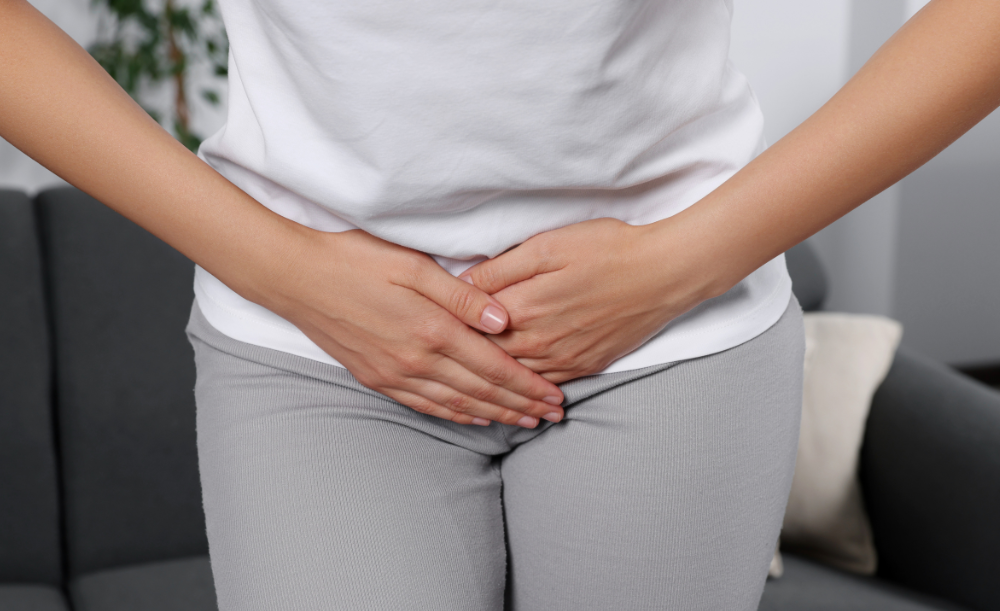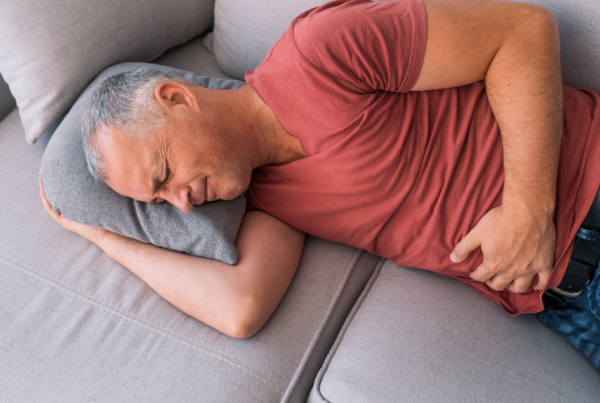Interstitial Cystitis
Move Better. Live Fuller. Your Wellness Journey Starts Here.
Schedule a FREE Discovery Call!
What Is Interstitial Cystitis (IC)?
Interstitial cystitis, also known as painful bladder syndrome (PBS), is a chronic condition that makes a person use the restroom more often, and void smaller amounts of urine. This is because of a dysfunction in the signals that are sent to the brain from the bladder, which usually are sent once the bladder is completely full.
People with IC feel the need to urinate more frequently. The bladder lining is typically inflamed or irritated for those with this condition, which can cause discomfort or pain with both holding and voiding urine.
The symptoms of interstitial cystitis can vary from person to person, and can change with time. They may be constant, or only happen intermittently. Some common symptoms for this condition include:

- Pelvic pain
- Bladder pain or discomfort
- Urgency
- Pain with urination
- Pain with intercourse
- Pain with a full bladder
- More severe symptoms during menstruation
- Pain in the lower back, rectum, or genitals
- Other referred pain
- Constipation
- Pelvic muscle spasms
What Causes Interstitial Cystitis?
Interstitial cystitis does not have an exact cause, although it is thought to be created by a combination of factors. Although there is no proven cause of this condition, research suggests it may be caused or affected by things such as:
- Damage to the bladder lining: Damage to the lining of the bladder would allow substances from urine to irritate the bladder wall, causing inflammation and pain. Things that could cause damage to the bladder lining include recurrent UTIs, trauma, or dietary irritants.
- Autoimmune diseases: Some research suggests that interstitial cystitis may be related to autoimmune disorders, in which the body mistakenly attacks the lining of the bladder and causes inflammation. This supposed cause has been suggested due to the presence of antibodies in some individuals with IC, which mimics other autoimmune conditions.
- Pelvic floor dysfunction: The pelvic floor muscles are directly involved with the health of the bladder, and so problems with the pelvic floor may cause further irritation of the bladder and a worsening of symptoms.
- Nerve sensitivity: Problems with nerve sensitivity may influence pain and other symptoms experienced with IC. There are many nerves throughout the pelvis, some of which directly affect the bladder. Hypersensitivity can create many painful symptoms, even without any physical damage to the bladder, and therefore may play a role in interstitial cystitis.
- Genetic predisposition: Some genes are being studied for their possible role in conditions like interstitial cystitis.
- Allergies or infections: Frequent infections or individual allergies may contribute to bladder inflammation.
Lastly, this condition seems to be more common in people who are assigned female at birth and are over the age of 30.
Some individuals with interstitial cystitis may also have triggers that cause flare-ups of symptoms, such as stress or dietary irritants (caffeine, spicy foods, citrus, etc.). Similarly, those with chronic conditions such as IBS, endometriosis, chronic infections, or fibromyalgia may have their condition or symptoms worsened due to the presence of these other conditions.
Physical Therapy for Interstitial Cystitis
Although there is no cure for this condition, physical therapy is available for people with interstitial cystitis to help better manage their symptoms. This condition often involves discomfort and pain as its primary symptoms, and seeking help from a pelvic floor physical therapist can help make these symptoms more tolerable or less severe. Pelvic floor therapists can provide support for patients with interstitial cystitis by using the following techniques:
- Neuromuscular re-education / biofeedback: Helps patients better understand contraction and relaxation of their pelvic floor, voiding techniques, and pelvic floor awareness.
- Manual therapy: Internal or external pelvic floor massage.
- Exercise prescription: Teaching down-regulation techniques with yoga, deep breathing, stretching, and dilation.
- Behavioral modifications: Suggestions and education for bathroom habits or dietary irritants that may make symptoms worse.
- Joint mobilization or spinal manipulation: To improve mobility and provide pain relief.
- Electrical stimulation: (Internal or external) Provides additional pain relief as needed.
In addition to these techniques, it can be helpful to see a physical therapist to maintain your pelvic floor health. Pelvic floor dysfunction may exacerbate interstitial cystitis symptoms, and IC can affect pelvic floor health. Therefore, to help relieve this cycle and reduce the severity of painful symptoms, working with a pelvic floor physical therapist can be a great help to managing your symptoms and maintaining the best possible health for your pelvic floor and bladder.
Although working with a pelvic floor physical therapist for interstitial cystitis can involve internal exams or treatment, you do have the right to consent to or not consent to these. At Hive Therapy and Wellness, our physical therapists will always request consent before performing any exams or treatments. They can still work with you in other ways if you choose not to proceed with internal procedures.
Interstitial cystitis, also known as painful bladder syndrome (PBS), is a chronic condition that makes a person use the restroom more often, and void smaller amounts of urine.
This is because of a dysfunction in the signals that are sent to the brain from the bladder, which usually are sent once the bladder is completely full. People with IC feel the need to urinate more frequently.
The bladder lining is typically inflamed or irritated for those with this condition, which can cause discomfort or pain with both holding and voiding urine.
The symptoms of interstitial cystitis can vary from person to person, and can change with time. They may be constant, or only happen intermittently. Some common symptoms for this condition include:
- Pelvic pain
- Bladder pain or discomfort
- Urgency
- Pain with urination
- Pain with intercourse
- Pain with a full bladder
- More severe symptoms during menstruation
- Pain in the lower back, rectum, or genitals
- Other referred pain
- Constipation
- Pelvic muscle spasms
Interstitial cystitis does not have an exact cause, although it is thought to be created by a combination of factors.
Although there is no proven cause of this condition, research suggests it may be caused or affected by things such as:
Damage to the bladder lining
Damage to the lining of the bladder would allow substances from urine to irritate the bladder wall, causing inflammation and pain.
Things that could cause damage to the bladder lining include recurrent UTIs, trauma, or dietary irritants.
Autoimmune diseases
Some research suggests that interstitial cystitis may be related to autoimmune disorders, in which the body mistakenly attacks the lining of the bladder and causes inflammation.
This supposed cause has been suggested due to the presence of antibodies in some individuals with IC, which mimics other autoimmune conditions.
Pelvic floor dysfunction
The pelvic floor muscles are directly involved with the health of the bladder, and so problems with the pelvic floor may cause further irritation of the bladder and a worsening of symptoms.
Nerve sensitivity
Problems with nerve sensitivity may influence pain and other symptoms experienced with IC. There are many nerves throughout the pelvis, some of which directly affect the bladder.
Hypersensitivity can create many painful symptoms, even without any physical damage to the bladder, and therefore may play a role in interstitial cystitis.
Genetic predisposition
Some genes are being studied for their possible role in conditions like interstitial cystitis.
Allergies or infections
Frequent infections or individual allergies may contribute to bladder inflammation.
Lastly, this condition seems to be more common in people who are assigned female at birth and are over the age of 30.
Some individuals with interstitial cystitis may also have triggers that cause flare-ups of symptoms, such as stress or dietary irritants (caffeine, spicy foods, citrus, etc.).
Similarly, those with chronic conditions such as IBS, endometriosis, chronic infections, or fibromyalgia may have their condition or symptoms worsened due to the presence of these other conditions.
Although there is no cure for this condition, physical therapy is available for people with interstitial cystitis to help better manage their symptoms.
This condition often involves discomfort and pain as its primary symptoms, and seeking help from a pelvic floor physical therapist can help make these symptoms more tolerable or less severe.
Pelvic floor therapists can provide support for patients with interstitial cystitis by using the following techniques:
- Neuromuscular re-education / biofeedback: Helps patients better understand contraction and relaxation of their pelvic floor, voiding techniques, and pelvic floor awareness.
- Manual therapy: Internal or external pelvic floor massage.
- Exercise prescription: Teaching down-regulation techniques with yoga, deep breathing, stretching, and dilation.
- Behavioral modifications: Suggestions and education for bathroom habits or dietary irritants that may make symptoms worse.
- Joint mobilization or spinal manipulation: To improve mobility and provide pain relief.
- Electrical stimulation: (Internal or external) Provides additional pain relief as needed.
In addition to these techniques, it can be helpful to see a physical therapist to maintain your pelvic floor health. Pelvic floor dysfunction may exacerbate interstitial cystitis symptoms, and IC can affect pelvic floor health.
Therefore, to help relieve this cycle and reduce the severity of painful symptoms, working with a pelvic floor physical therapist can be a great help to managing your symptoms and maintaining the best possible health for your pelvic floor and bladder.
Although working with a pelvic floor physical therapist for interstitial cystitis can involve internal exams or treatment, you do have the right to consent to or not consent to these.
At Hive Therapy and Wellness, our physical therapists will always request consent before performing any exams or treatments. They can still work with you in other ways if you choose not to proceed with internal procedures.
You can learn more about these treatments on our Treatments Page.





